Trabzon Hakkında Temel Bilgiler

Vali
Aziz YILDIRIM

Büyükşehir Belediye Başkanı
Ahmet Metin GENÇ
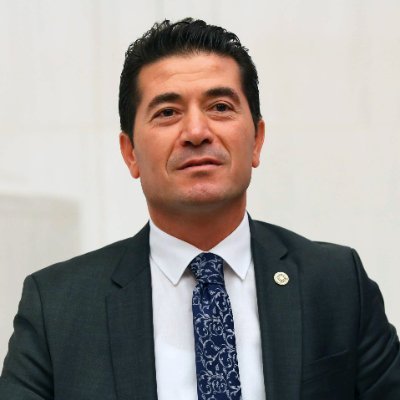
Ortahisar Belediye Başkanı
Ahmet KAYA
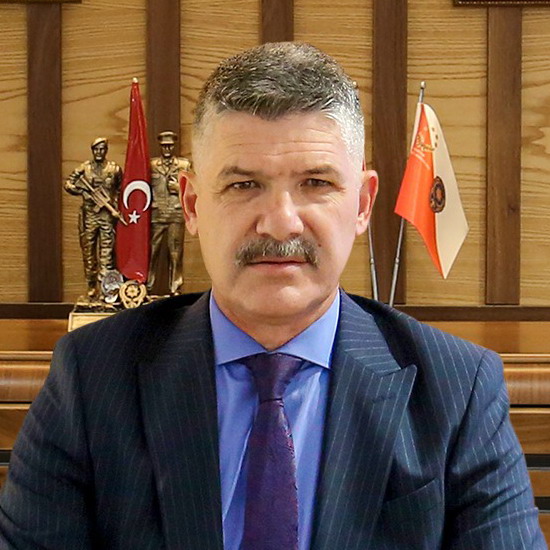
Emniyet Müdürü
Murat ESERTÜRK

Ticaret ve Sanayi Odası Başkanı
Erkut ÇELEBİ

Karadeniz Teknik Üniversitesi Rektörü
Prof.Dr.Hamdullah ÇUVALCI
- GENEL BİLGİLER
- İLÇELER
- KARDEŞ ŞEHİRLER
- TARİHÇE
- İKLİM
- EKONOMİ
- TİCARET ve SANAYİ
- EĞİTİM ve KÜLTÜR
- COĞRAFİ DURUM
- SAĞLIK
Trabzon 81 il arasında,
Yüzölçümü itibariyle 62.
Nüfus itibariyle 23.
Nüfus yoğunluğu bakımından 5.
Nüfus artış hızı ile de 59.
sırada yer almaktadır.
Nüfusun % 37’si 25 yaş altı, % 52’si 25-65 yaş, % 11’i 65 yaş üstüdür.
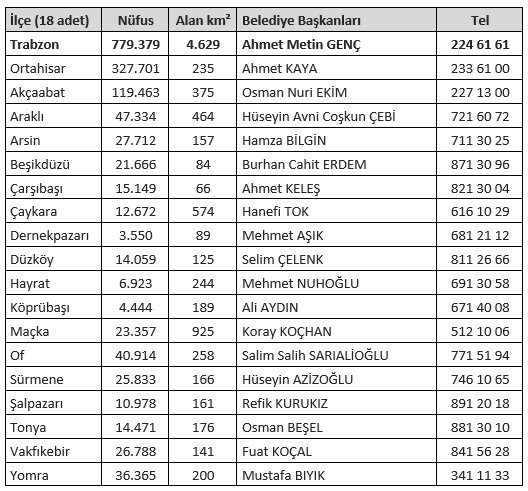
Zigetvar, Macaristan (1998)
Kahramanmaraş, Türkiye (2006)
Soçi, Rusya (1993)
Dortmund, Almanya (2013)
Rizhao, Çin Halk Cumhuriyeti (1997)
Travnik, Bosna-Hersek (2005)
Chicago, Amerika Birleşik Devletleri (1998)
Reşt, İran (2000)
Batum, Gürcistan (2000)
Zencan, İran (2001)
Trabzon'un kuruluşu M.Ö.2000 yıllarına inmektedir. Tarihi İpek Yolunun başlangıcında kurulan Trabzon şehrinin ilk kurucularının Ortaasya ve Kafkaslardan bölgeye gelen Turani Kavimlerden Marlar, Tibarenler ve Moskların olduğu tarih kitaplarında yer almaktadır.
I.Devir: Şehrin kuruluşu (M.Ö.2000-M.Ö.750)
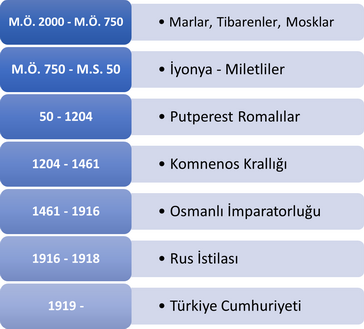 Bu devir karanlık geçen bir devirdir. Kalıntılar bize bu bölgeye ilk defa Kafkasya'dan Mosklar, Tibarenler ve Marların gelerek tarım ve balıkçılık ile meşgul olduklarını bildirmektedir.
Bu devir karanlık geçen bir devirdir. Kalıntılar bize bu bölgeye ilk defa Kafkasya'dan Mosklar, Tibarenler ve Marların gelerek tarım ve balıkçılık ile meşgul olduklarını bildirmektedir.
II.Devir:Serbest Şehir Devri (M.Ö.750-M.S.50)
Bu devirde M.Ö.756 yılında Sinop'tan Miletliler Trabzon'a gelmişlerdi. Zamanlarının en iyi denizci ve tüccarları olan bu kolönizatörler aslen İyonya'nın en önemli merkezlerinden Milet şehrindendirler.
Miletliler, Sinop'u elde ettikten 29 yıl sonra Ordu ve Giresun ile birlikte, kendilerinden önce var olan Trabzon'a da gelmişler ve ne şekilde olduğu bilinmeyen bir surette yerleşmişlerdir.
Şehirden ilk bahseden, M. Ö. 400 yılında Onbinlerin bakiyesi olan sekizbinküsür kişilik ordu ile Trabzon'a gelen Yunanlı komutan ve filozof Ksenefon'dur. Şehir O'nun zamanında Sinop'a belli bir vergi ödüyordu.
Miletliler, Trabzon'dan Asya'nın göbeğine ve Ortadoğuya ulaşan ticaret yolları üzerinden akan alışveriş hareketlerinin bağlanıp çözüldüğü Trabzon'da çok büyük servetler elde etmişler ve merkezleri olan Sinop'u her sahada geride bırakmışlardı. Trabzonluların yüzlerce parçalık gemileri gelen ve giden ticaret emtiasını Karadeniz'in her tarafına ve boğazları aşarak Ege kıyılarına taşıyordu.
III. Devir: Putperest Romalılar (50-1204)
Pontus İmparatoru Mithridates'in Roma İmparatorluğu ile giriştiği bir dizi savaşı kaybetmesinin ardından Anadolu topraklarının yanı sıra Trabzon da Roma hakimiyetine girmiştir. Romalılar, diğer Yunan sömürgelerine yaptıkları gibi Trabzon'a da "Serbest Şehir" unvanı ve imtiyazını bırakmışlardı. Trabzon Romalılar için doğuda bir üs ve iaşe merkezi halini almıştı. Karadeniz'deki Yunan sömürgelerinin merkezi olan Sinop, Roma döneminin başında önemini kaybetmişti. Trabzon ise giderek güç kazanmış ve Karadeniz'in en işlek iskelesi, en canlı ticaret merkezi haline gelmişti.
Romalılar Trabzon'a konumundan dolayı özel önem veriyorlardı. Roma imparatoru Adrian M. S. birinci yüzyılda şimdiki Kalepark'ın denize doğru uzanan kayaların altını oydurarak bir liman yaptırmıştı. Latince Bella Castron limanı olarak anılan bu liman, Avrupa-Asya ve Ortadoğu ticaretinde çok önemli bir yere sahipti. İçten veya denizden gelen transit emtia deve ve gemilerden, limanın tam üstündeki etrafı surla çevrili olan ve zamanına göre umumi mağaza mahiyetinde olan bu antrepoya boşaltılır, içeriye veya taşraya gidecek olan emtia dahi oradan yüklenirdi. Burası Avrupa'dan Asya'nın ortalarına kadar ulaşan tarihi ipek yolunun deniz ucundaki basamağında kurulan bugünkü manasıyla bir serbest bölge idi.
Roma İmparatoru Hadrian döneminde restore edilen kente, Trajan döneminde Pontus Kapadokyası eyaletinin başkenti olmuş ve yeni bir liman inşa edilmiştir. Gallianus döneminde bir Germen kabilesi olan Gotlar tarafından yağmalanmış, Justinian döneminde tekrar onarılarak eski konumunu kazanmıştır.
IV. Devir: Komnenos Krallığı (1204-1461)
Bizans İmparatorluğunun 1204 de IV. Haçlı seferleriyle gelen Latinlerin eline geçmesi üzerine, imparator I. Andronikos Komnenos’un İstanbul’dan kaçan torunları Alexios ve David, Gürcü Kraliçesi Tamara’nın da yardımıyla Trabzon’da 1204 yılında bağımsız olarak Trabzon Komnenos İmparatorluğu’nu kurmuşlardır.
 Trabzon İmparatorluğu'nu kurduğunda 22 yaşında olan I. Alexios burada kendisini "Roma İmparatoru" olarak tanımlamıştır. Trabzon Ordusu'nun başkomutanı olan Alexios'un kardeşi David, Laz ve Gürcülerden oluşan ordusuyla Paflagonya'ya saldırmış böylece Karadeniz Ereğlisi ile Sinop arasındaki arazi de Trabzon topraklarına katılmıştır. Trabzon İmparatorluğu'nun savunmasını güçlendirip, Trabzon ticaretini zenginleştiren Aleks 18 yıl hükümdarlık yaptıktan sonra 1222 tarihinde 40 yaşında ölmüştür.
Trabzon İmparatorluğu'nu kurduğunda 22 yaşında olan I. Alexios burada kendisini "Roma İmparatoru" olarak tanımlamıştır. Trabzon Ordusu'nun başkomutanı olan Alexios'un kardeşi David, Laz ve Gürcülerden oluşan ordusuyla Paflagonya'ya saldırmış böylece Karadeniz Ereğlisi ile Sinop arasındaki arazi de Trabzon topraklarına katılmıştır. Trabzon İmparatorluğu'nun savunmasını güçlendirip, Trabzon ticaretini zenginleştiren Aleks 18 yıl hükümdarlık yaptıktan sonra 1222 tarihinde 40 yaşında ölmüştür.
I. Alexios'tan sonra tahta geçen Andronik, döneminde Selçuklularla şiddetli çarpışmalar yaşanmıştır. Andronik kazandığı zaferler onuruna sütunlar diktirmiş ve kendi adına altın sikke bastırmıştır.
Andronik saltanatını takiben I. John başa geçmiş onu da I. Manuel izlemiştir. I. Manuel Moğollarla iyi ilişkiler geliştirmiş Trabzon ticari önemini korumaya devam etmiştir. Trabzon Ayasofya Kilisesi onun döneminde inşa edilmiştir.
Trabzon İmparatorluğu en parlak dönemini II. Aleks döneminde yaşamıştır. Onun döneminde Giresun'a sızmaya çalışan Türkmenler bu bölgelerden çıkarılmışlardır. İmparatorluğun savunmasını da arttırarak gece-gündüz devriye atacak güvenlik kuvvetleri oluşturmuştur.
II. Aleks'ten sonra tahta çıkan III. Andronik döneminde ilk kez iç savaş ve Büyük Düka John önderliğinde isyan çıkmıştır. Bunun sebebi Andronik'in tahta çıkar çıkmaz kardeşlerini öldürtmesidir. Halk bunu hoş karşılamayarak onun soyunu tahttan men etmiş yerine ise Gürcü lider Basil Komnene tahta çıkarılmıştır.
Basil'in yerel lordları öldürmesiyle gerginleşen ortama halkın hoş bakmadığı başka durumlar da eklenince bir Güneş tutulmasında halk imparatora başkaldırmıştır. Daha sonra Basil'i zehirleyen ilk eşi Trabzon tahtına oturmuştur. Fakat o da Basil'in kendisini bırakarak evlendiği ikinci eşi Trabzonlu İrene'yi ülkeden kovunca tekrar iç savaş çıkmıştır. II. Aleks'in kızı Anna, yerli askerlerin yardımıyla Trabzon tahtını ele geçirmiş, İstanbullu Kraliçeyi de İstanbul'a geri göndermiştir. Anna'nın tahta geçmesi yerlilerin güçlenmesi Roma'nın bölgedeki etkinliğini kaybetmesi demekti. Ceneviz gemileriyle Trabzon'a gelen III. John, İmparatoriçe Anna'yı boğdurarak başa geçmiştir.
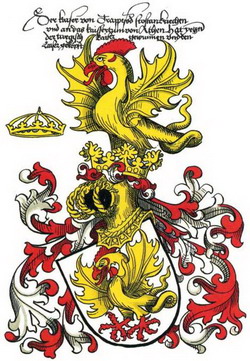 Trabzon İmparatorluğu 1340'larda büyük bir veba salgınıyla sarsılmıştır. Tüm iç karışıklıklar, veba salgını, depremler, İtalyan ve Türkmenlerle girilen çatışmalar Trabzon İmparatorluğu'nu zayıf düşürmüş ve Panaret'in Kronik'inde "felaket" olarak adlandırılan Gürcistan'ın Timur tarafından işgali gerçekleşmiştir.
Trabzon İmparatorluğu 1340'larda büyük bir veba salgınıyla sarsılmıştır. Tüm iç karışıklıklar, veba salgını, depremler, İtalyan ve Türkmenlerle girilen çatışmalar Trabzon İmparatorluğu'nu zayıf düşürmüş ve Panaret'in Kronik'inde "felaket" olarak adlandırılan Gürcistan'ın Timur tarafından işgali gerçekleşmiştir.
15. yüzyıla girerken de Osmanlı Devleti ile Trabzon İmparatorluğu artık sınır komşusu olmuşlardır. Aynı dönemde Türkmenler de Giresun'a girmişlerdir. Trabzon, Osmanlı tarafından ilk kez 1440'larda kuşatılmışsa da alınamamıştır. Yine akabinde Şeyh Cüneyd önderliğindeki Türkmenler, Trabzon'u kuşatmışlarsa da geri çekilmek zorunda kalmışlardır.
Trabzon imparatorları başlangıçta diğer Bizans (Doğu Roma) imparatorları gibi çift başlı (aetos) figürünü sembol olarak kullanmışlarsa da Latin işgalinin sona ermesi ve Konstantinapolis'de yeniden yasal yönetimin iktidarı ele geçirmesiyle, bir çatışmaya sebebiyet vermemek için bugün Trabzon Ayasofya müzesinin giriş kapısının üzerinde rölyefi bulunan tek başlı kartal sembolü tercih etmişlerdir.
V. Devir: Osmanlı İmparatorluğu (1461-1918)
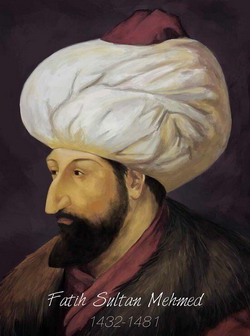 2. Bayezid’in 1398 de Samsun yöresini almasından sonra Trabzon Komnenos Krallığı Osmanlı Devleti’ne yıllık vergi ödemek zorunda bırakılmıştır. David Komnenos, iktidarı döneminde (1458-1461) vergi ödemeyi durdurarak, önceden ödediklerini de Akkoyunlu Devleti Sultanı Uzun Hasan aracılığıyla geri istemiş, Osmanlılara karşı Avrupa’daki büyük devletlere ittifak önerisinde bulunmuştur. Bunun üzerine Fatih Sultan Mehmet’in öncülüğündeki Osmanlı Kuvvetleri Bölgeyi kuşatarak, 1461 yılında Trabzon’u ele geçirmiş ve Komnenosların egemenliğine son vermiştir. Trabzon, Osmanlı Döneminde önce eyalet ve sancak olarak şehzade ve mutasarrıflar tarafından idare edilmiştir. İlk sancak beyi Hızır Bey’dir. 1470 yılında sancak beyliği küçük yaşta Şehzade Abdullah’a verilmiş; Abdullah, annesi Şirin Hatunla birlikte 1479 yılına kadar Trabzon’da yaşamıştır. Yavuz Sultan Selim de şehzadeliği sırasında (1491-1512) Trabzon’da Sancak Beyi olarak bulunmuş, sonradan Kanuni ünvanı alacak olan oğlu Sultan Süleyman burada doğmuştur. Trabzon 16. yüzyılda, merkezi Batum olan Lazistan Sancağı ile birleştirilerek eyalete dönüştürülmüş ve bu yeni idari birimin merkezi olmuştur. 1859-1864 yılları arasında Kuzey Kafkasya'da süregelen Kafkas-Rus savaşı, Çerkes ve Abaza halkının yenilgisi ile sonuçlanmış ve şehre sayıları 360 binin üzerinde göçmenin yığılmasına yol açmıştır. Doğal olarak büyük bir afete dönüşen göç, salgın hastalıklar, açlık ve toplum içinde kaynaşmalara yol açmıştır. Çok kısa bir zaman içinde Trabzon ve Akçakale limanları ve çevresindeki yerleşim yerleri adeta rezervasyonlara dönüşmüştür. Bu dönem sırasında salgın hastalıklardan korkarak kaçan yerel halk yaylalara geçmiş ve şehirde yeni göçmenlerle, devlet görevlilerinden başka sadece kaçamayacak durumda olanlar kalmıştır. 1867 yılında Trabzon’da büyük bir yangın çıkmış, bir çok kamu binası da bu sırada yanmış ve kent daha sonra yeniden düzenlenmiştir. 1868 yılında vilayet olmuş, merkez sancağı dışında Lazistan, Gümüşhane, Canik Sancakları da buraya bağlanmıştır. Birinci Dünya Savaşı sırasında, Ruslar Trabzon’a saldırmıştır (14 Nisan 1916). Trabzonlulardan oluşan vurucu güçler (Milis), bu saldırı sırasında gerilla savaşı vermiştir. Bu sıralarda, cepheye gönderilmek üzere Hamidiye Zırhlısının desteğinde Trabzon Limanına gelen cephane Trabzonlu gençlerce büyük bir heyecan içinde boşaltılıp Maçka’ya taşınmıştır.
2. Bayezid’in 1398 de Samsun yöresini almasından sonra Trabzon Komnenos Krallığı Osmanlı Devleti’ne yıllık vergi ödemek zorunda bırakılmıştır. David Komnenos, iktidarı döneminde (1458-1461) vergi ödemeyi durdurarak, önceden ödediklerini de Akkoyunlu Devleti Sultanı Uzun Hasan aracılığıyla geri istemiş, Osmanlılara karşı Avrupa’daki büyük devletlere ittifak önerisinde bulunmuştur. Bunun üzerine Fatih Sultan Mehmet’in öncülüğündeki Osmanlı Kuvvetleri Bölgeyi kuşatarak, 1461 yılında Trabzon’u ele geçirmiş ve Komnenosların egemenliğine son vermiştir. Trabzon, Osmanlı Döneminde önce eyalet ve sancak olarak şehzade ve mutasarrıflar tarafından idare edilmiştir. İlk sancak beyi Hızır Bey’dir. 1470 yılında sancak beyliği küçük yaşta Şehzade Abdullah’a verilmiş; Abdullah, annesi Şirin Hatunla birlikte 1479 yılına kadar Trabzon’da yaşamıştır. Yavuz Sultan Selim de şehzadeliği sırasında (1491-1512) Trabzon’da Sancak Beyi olarak bulunmuş, sonradan Kanuni ünvanı alacak olan oğlu Sultan Süleyman burada doğmuştur. Trabzon 16. yüzyılda, merkezi Batum olan Lazistan Sancağı ile birleştirilerek eyalete dönüştürülmüş ve bu yeni idari birimin merkezi olmuştur. 1859-1864 yılları arasında Kuzey Kafkasya'da süregelen Kafkas-Rus savaşı, Çerkes ve Abaza halkının yenilgisi ile sonuçlanmış ve şehre sayıları 360 binin üzerinde göçmenin yığılmasına yol açmıştır. Doğal olarak büyük bir afete dönüşen göç, salgın hastalıklar, açlık ve toplum içinde kaynaşmalara yol açmıştır. Çok kısa bir zaman içinde Trabzon ve Akçakale limanları ve çevresindeki yerleşim yerleri adeta rezervasyonlara dönüşmüştür. Bu dönem sırasında salgın hastalıklardan korkarak kaçan yerel halk yaylalara geçmiş ve şehirde yeni göçmenlerle, devlet görevlilerinden başka sadece kaçamayacak durumda olanlar kalmıştır. 1867 yılında Trabzon’da büyük bir yangın çıkmış, bir çok kamu binası da bu sırada yanmış ve kent daha sonra yeniden düzenlenmiştir. 1868 yılında vilayet olmuş, merkez sancağı dışında Lazistan, Gümüşhane, Canik Sancakları da buraya bağlanmıştır. Birinci Dünya Savaşı sırasında, Ruslar Trabzon’a saldırmıştır (14 Nisan 1916). Trabzonlulardan oluşan vurucu güçler (Milis), bu saldırı sırasında gerilla savaşı vermiştir. Bu sıralarda, cepheye gönderilmek üzere Hamidiye Zırhlısının desteğinde Trabzon Limanına gelen cephane Trabzonlu gençlerce büyük bir heyecan içinde boşaltılıp Maçka’ya taşınmıştır.
Çaykara’da Sultan Murat Yaylası’nda (10 Haziran 1916), Of’ta Baltacı, Arsin’de Yanbolu Derelerinde Ruslara karşı başarılı savaşlar verilmiş, ancak o yıllardaki koşullar altında düşmanın Trabzon’a girmesine engel olunamamış ve Ruslar 14 Nisan 1916 yılında Trabzon’a girmiştir. Rusların Trabzon’da kaldığı bir yıl, on ay, on günlük süre içinde özellikle Rumlar ve Ermeniler, yerli halka büyük işkenceler yapıp; sayısız insan öldürmüştür.
1917′de Rusya’da “Bolşevik Devrimi” olur, Çarlık Yönetimi yıkılır. Bunun üzerine Rus Ordusu’nda büyük bir panik başlar. Bu Rusların Trabzon’dan çekilmesine de yol açar. Öte yandan, batıdan doğuya doğru kayan ve Karadağ’da toplanan Türk Çeteleri, Akçaabat’a inerek Yüzbaşı Kahraman Bey’in komutasında üç koldan Trabzon’a doğru yürürler ve 24 Şubat 1918 tarihinde Trabzon’a girerler.
VI. Devir: Türkiye Cumhuriyeti
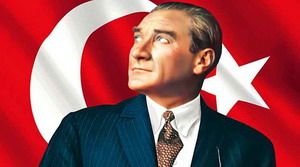 Osmanlı İmparatorluğu’nun yıkılmasından sonra Mustafa Kemal Atatürk ve arkadaşları yeni Türk devleti olan Türkiye Cumhuriyeti’ni kurmuşlar ve Trabzon da yeni ülkenin yeni idari yapısında altmışbir (61) nolu il olarak yerini almıştır. İlin Cumhuriyet dönemindeki sınırları kültürel ve tarihsel bir düşünceyle değil tamamen idari yapı ve merkezlere uzaklıklar baz alınarak çizilmiştir. Cumhuriyetin ilanından sonra Trabzon’da çeşitli fabrikalar kurulmuştur. Atatürk, Cumhuriyet döneminde Trabzon’a 1924, 1930 ve 1937 yıllarında üç kez gelir. İlk geldikleri 15 Eylül 1924 günü, Trabzonlularca “ATATÜRK GÜNÜ” olarak kabul edilir.
Osmanlı İmparatorluğu’nun yıkılmasından sonra Mustafa Kemal Atatürk ve arkadaşları yeni Türk devleti olan Türkiye Cumhuriyeti’ni kurmuşlar ve Trabzon da yeni ülkenin yeni idari yapısında altmışbir (61) nolu il olarak yerini almıştır. İlin Cumhuriyet dönemindeki sınırları kültürel ve tarihsel bir düşünceyle değil tamamen idari yapı ve merkezlere uzaklıklar baz alınarak çizilmiştir. Cumhuriyetin ilanından sonra Trabzon’da çeşitli fabrikalar kurulmuştur. Atatürk, Cumhuriyet döneminde Trabzon’a 1924, 1930 ve 1937 yıllarında üç kez gelir. İlk geldikleri 15 Eylül 1924 günü, Trabzonlularca “ATATÜRK GÜNÜ” olarak kabul edilir.
Trabzon iklimi yazın sıcak kışın ise normal soğukluktadır. İlkbahar aylarıgenellikle yağmurlu ve sislidir. Trabzon nemli bir iklime sahip, olup nem oranı zaman zaman %99'lara kadar çıkmaktadır.
Yıllıkortalama yağış miktarı 800-850 kg/m²’dir. İç kesimlere doğru çıkıldıkça yağmur oranı da artmaktadır. Enaz yağmur yağan aylar Temmuz ve Ağustos ayları olup en çok kar ise Şubat ayında yağmaktadır.
İkliminin ılık ve yumuşakolduğu söylenebilir. Sahilden içe doğru gidildikçe havanın daha güzel, suyun daha temiz olduğugörülür.
Karadeniz'e özgü ılıman iklime sahip kentte hava sıcaklığı yıl boyunca 7,4-23,5 °C arasında değişirken yaz ortalaması 22,3 °C, kış ortalaması ise 4,4 °C civarındadır.
Trabzon'da bugüne kadar ölçülen en düşük sıcaklık -7 °C (15 Ocak 1950), en yüksek sıcaklık ise 37,8 °C (17 Mayıs 1988) olmuştur

Trabzon kültürel ve sosyal yönden gelişmiş olmasına rağmen, arzulanan ekonomik gelişmeyi sağlayamamıştır. İlin ekonomisi halen tarım ve hayvancılığa dayanmaktadır. Nüfusun % 65'i bu faaliyetlerde elde edilen gelirlerle geçimini sağlamaktadır.
Ticaret, sanayi, el sanatları, taşımacılık, inşaat ve diğer hizmetler alanında istihdam edilenler ise nüfusun % 35'ini oluşturmaktadır.
Trabzon’da işgücüne katılım oranı %50,3, istihdam oranı %46,6, işsizlik oranı ise %7,4’tür. (Türkiye ortalamaları sırasıyla %48,3 - %43,9 - %9) 2012 verilerine göre Trabzon’da İŞKUR’a kayıtlı 24.057 işsiz bulunmakta, bunların 13.915’ini erkekler, 10.142’sini ise kadınlar oluşturmaktadır. İşsizlerin %13,9’unu üniversite mezunu oluşturmaktadır. Trabzon, her yıl üniversitelerinin verdiği 60 bin lisans ve lisansüstü mezunu ile bir eğitim şehri olarak ön plana çıkmakta, bu sayede de yüksek ve nitelikli işgücü potansiyeline sahip olmaktadır.
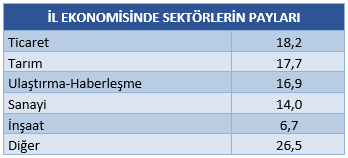
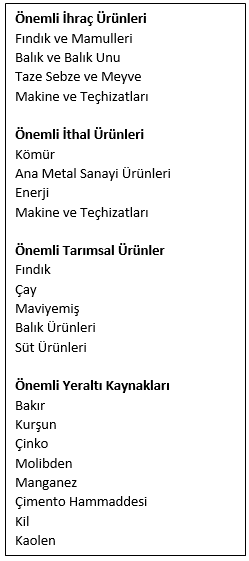


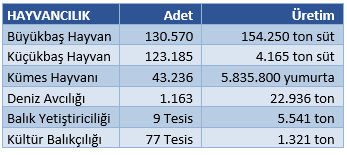
DIŞ TİCARET
2013 yılında Trabzon’daki ihracat 1,1 milyar dolar olarak gerçekleşmiştir. Bu miktarla Trabzon 18 Karadeniz Bölgesi ili arasında 1. Türkiye genelindeki bütün iller arasında ise 15. sıradadır. Öte yandan, ilin toplam ithalatı 223 milyon dolar olarak gerçekleşmiştir. Trabzon’un genel ihracatının %62’sini "Tarım, avcılık ve ilgili hizmet faaliyetleri" oluşturmaktadır ve bu durumun da ağırlığı fındık ihracatına dayanmaktadır. Yaş meyve ve sebze ihracatı ise %35’lik payla ikinci sıradadır.
SANAYİ
Trabzon’da Sanayi Sicil Belgesine sahip yaklaşık 500 firma olup bu firmaların %26’sı , birçoğu fındık, çay ve su ürünleri alt sektörleri başlığı altında “Gıda ve İçecekler” sektöründe faaliyet göstermektedir. İnşaat Ürünleri imalatı yapan firmalar %17’dir.
Firmaların %28’si mikro ölçekli, % 60’ı küçük ölçekli, %10’u orta ölçekli ve %2’si ise büyük ölçekli işletmelerden oluşmaktadır. Sanayi Sicil Belgesi almış firmaların, 35’inde Araştırma ve Geliştirme (Ar-Ge) Departmanı, 108’inde ise Kalite Kontrol Departmanı bulunmaktadır.
Trabzon’da ikisi faal (Arsin OSB ve Beşikdüzü OSB), biri kurulum aşamasında (Akçaabat Şinik OSB) ve diğeri de kamulaştırma ve yapım aşamasında (Vakfıkebir OSB) olmak üzere 4 Organize Sanayi Bölgesi bulunmaktadır. Fiili üretim yapan 88 firmaya sahip Arsin OSB, 4200 istihdamı, yıllık 305 milyon $’lık ihracatı ve yüksek ticaret hacmi ile Doğu Karadeniz Bölgesinin en büyük Organize Sanayi Bölgesidir. Beşikdüzü OSB’de, üretim halinde 18 firma yer alırken, OSB’nin istihdamı 303 kişi, ve yıllık ihracatı ise 3 milyon USD’dır. Akçaabat Şinik OSB’nin 48 parseli 31 şirkete tahsis edilmiştir. Trabzon’da 845 işletmenin faaliyet gösterdiği ve yaklaşık 3.000 kişilik istihdama sahip 9 Küçük Sanayi Sitesi bulunmaktadır.
LOJİSTİK
Uluslararası otoyol bağlantıları ve dağlardaki geçitler ile hem komşu ülkelere hem de içerideki bölgelere rahat ulaşım sağlanmaktadır. Trabzon Havalimanı iç hatlar yoğunluğu bakımından Türkiye’de 7. Sırada yer almakta ve hava kargoculuğunda önemli bir konumdadır. Yılda 22 binden fazla uçuş ve yaklaşık 3 Milyon yolcuya sahip olan havalimanından Almanya ve Rusya’ya tarifeli seferler, Suudi Arabistan’a ise charter seferleri ile doğrudan uçuş imkanı bulunmaktadır. Bölgenin en büyük limanı konumunda bulunan Trabzon Limanı, 10 milyon ton/yıl elleçleme, 5 milyon ton/yıl depolama ve yılda 2.300 gemi kabul kapasitesine sahiptir. Ayrıca turizm içinde büyük önem arz eden liman 2013 yılında 32 kruvaziyergemsi ile toplam in 20 bin ziyaretçiye hizmet vermiştir. Liman içerisindeki Trabzon Serbest Bölgesi, yatırımcılara dış ticaret alanında önemli fırsatlar sunmaktadır.
EĞİTİM
Trabzon’da okuma yazma oranı erkeklerde %98,66, kadınlarda % 91,29 olup genelde ise %94,92’dir. İlde, yüksekokul, lisans veya daha üst düzeyde mezuniyeti olan 79.681 kişi bulunmaktadır. İlköğretim ve ortaöğretimde okullaşma oranı Türkiye ortalamasının üzerindedir. İlköğretim ve ortaöğretimde derslik başına düşen öğrenci sayısı,Türkiye ortalaması 29 iken Trabzon’da bu rakam 23’dür. Trabzon’da Okul Öncesi, İlköğretim, Genel Ortaöğretim ve Mesleki-Teknik Orta Öğretim eğitim kuruluşlarının toplam sayısı 894 olup, bu okullarda eğitim-öğretim gören öğrenci sayısı ise 139.152’dir. Ayrıca, ilde kalifiye işgücünün artmasına katkı veren 18 Halk Eğitim Merkezi bulunmaktadır. İlin devlet üniversitesi olan KTÜ (Karadeniz Teknik Üniversitesi) 7 Enstitü, 17 fakülte, 11 Meslek Yüksekokulu, 23 Araştırma ve Uygulama Merkezi ve 1 konservatuvar olmak üzere 62 akademik birimden oluşmaktadır. 2011/2012 eğitim öğretim yılında, KTÜ’de toplam akademisyen sayısı 2.151’e ulaşmış olup, bu rakamın 299’u Profesörlerden oluşmaktadır. İlin bir diğer üniversitesi olan Avrasya Üniversitesi, Doğu Karadeniz Bölgesi’nin ilk vakıf üniversitesidir. Avrasya Üniversitesi’nde 2011-2012 eğitim-öğretim yılında, 14 Profesör dahil olmak üzere toplam akademik kadro sayısı 66 kişi olarak gerçekleşmiştir. Ayrıca bir başka devlet üniversitesi, 8 Mayıs 2018'de Karadeniz Teknik Üniversitesi'nden ayrılarak Trabzon Akçaabat'ta kurulmuş olan Trabzon Üniversitesi kısaca (TRÜ) bölgede yer almaktadır.
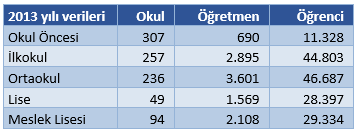
SOSYAL VE KÜLTÜREL YAŞAM
Trabzon’da 6 tiyatro, 68 sinema, 4 müze, 198 kütüphane, 10 yerel gazete ve 3 de alışveriş merkezi vardır. Trabzon sosyal ve kültürel imkânları ile tercih edilebilir bir ildir. Özellikle 3 tane alışveriş merkezine sahip olmak Trabzon’u Doğu Karadeniz Bölgesi’nde bir cazibe merkezi yapmaktadır.
Dağlar : Trabzon topraklarının % 78’i dağlardan ve % 22’si platolardan meydana gelir.
Dağlar ilin güneyinde ve kıyıya paralel olarak uzanır. Bu dağlar üç blok hâlindedir. Bunlar;
Zigana Dağları, Trabzon Dağları ve Soğan Dağları’dır.
Yaylalar : 1.750 – 2.200 m yüksekliklerdeki platolarda pek çok yayla vardır. Başlıca yaylalar;
Mescit Yaylası, Sultan Murâd Yaylası, Aşot ve Reşadiye Yaylası, Fikonov Yaylası,
Beypınarı Yaylası, Maçka Yaylası, Sakaltutan Yaylası ve Derinoba yaylalarıdır.
Akarsular : Trabzon toprakları içinde çok sayıda akarsu vardır.
Başlıcaları Değirmendere 35 km ve Karadere 56 km’dir. Diğerleri kısa ve hızlı akan sulardır.
Göller : Trabzon’da büyük göller yoktur. Birkaç küçük göl vardır. Bunlar;
Uzun Göl: Çaykara’ya bağlıdır. Gölde bol alabalık yaşar.
Denizden yüksekliği 1.250 m, derinliği 15 m, boyu 1 km, eni 500 m’dir.
Çakır Göl:Çakırgöl Dağı’nın kuzey yamacında yer alan bir buzul yatağı gölüdür. Gölde alabalık yaşar.
Denizden yüksekliği 2.533 m, derinliği 20 m, boyu 250 m, eni 200 m’dir.
Sera Gölü: 1950’de bir dağ yamacı kayarak Sera Deresi Vâdisinin bir kısmını kapatmasıyla oluşmuştur.
Derinliği 40-50 m, boyu 3 km, eni 200 m. Gölde sazan balığı üretilmektedir.
YERALTI KAYNAKLARI
Trabzon metalik madenler ve endüstriyel hammaddeleri açısından çok çeşitli maden yataklarına sahiptir. İldeki en önemli metalik mineraller Bakır, Kurşun, Çinko, Molibden ve Manganez cevherleşmesidir. Araştırmalara göre, ilde 74 metalik maden yatağı ve zuhuru tespit edilmiştir. Bakır-Kurşun-Çinko-Pirit-Molibden gibi önemli maden yatakları özellikle Maçka, Sürmene, Yomra ve Of İlçelerinde yoğunlaşmıştır. İlde bulunan önemli endüstriyel hammaddeler ise; çimento hammaddesi, kil ve kaolindir. Çoğunlukla, inşaat sektöründe dolgu veya endüstriyel hammadde tedarik kaynağı olarak kullanılmakta olan taş ocakları yönünden il büyük bir potansiyele sahiptir.
Trabzon 2 üniversite, 17 devlet ve 3 özel hastanesi, sağlık tesisleri, altyapısı ve personeli ile Türkiye’nin önde gelen sağlık merkezlerinden biri konumundadır. Kamu, özel ve üniversite hastaneleri hem kendi vatandaşlarımız hem de yakın coğrafya ve komşu ülkelerden gelen hastalara hizmet sunmaktadırlar. Her 1000 kişiye düşen yatak sayısı Trabzon’da 4,5 iken Türkiye ortalaması sadece 2,65’tir. Her 1000 kişiye düşen hekim sayısı 2,3 iken Türkiye genelinde bu sayı 1,7 olarak gerçekleşmiştir. Ayrıca Trabzon, sağlık turisti sayısı bakımından ilk 10 şehir arasında yer almaktadır.
